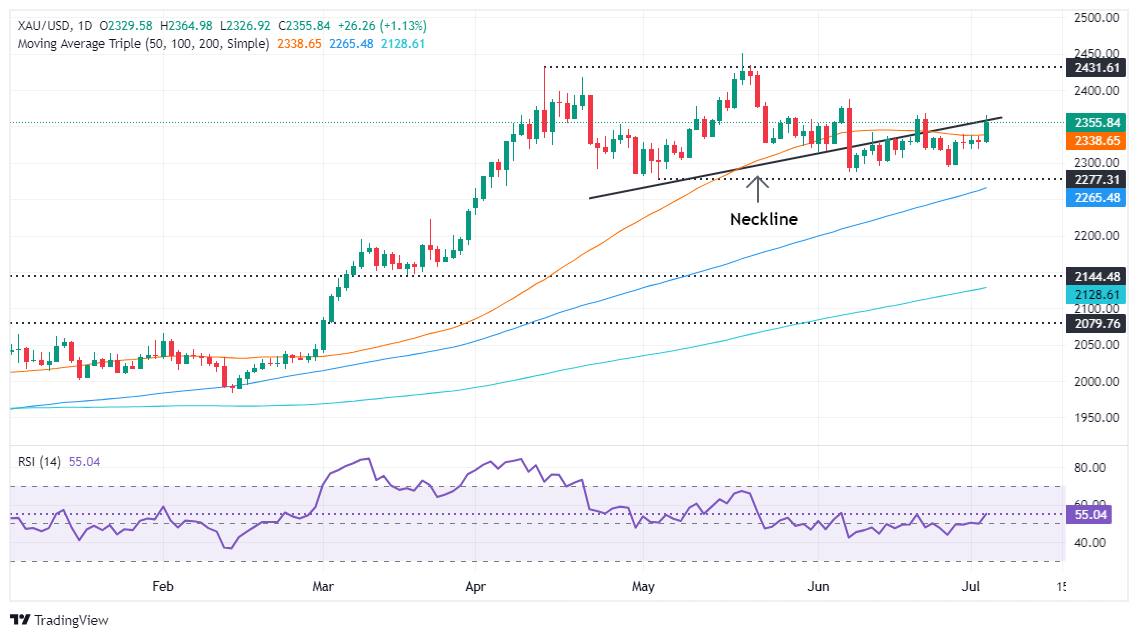Gold price climbs after FOMC Minutes leave USD unmoved

- Gold climbs, spurred by weak US economic data and rising Fed rate cut expectations.
- FOMC Minutes: readiness to hike rates if inflation persists, but current policy seen as restrictive.
- ISM shows contracting US services activity; labor market data reveals higher unemployment claims, decreased private hiring.
- Attention turns to Friday’s Nonfarm Payrolls, with US markets closed Thursday for Independence Day.
Gold price surged over 1% on Wednesday after softer-than-expected economic data from the United States increased bets that the Federal Reserve (Fed) could cut interest rates by September. In the meantime, the latest FOMC meeting minutes showed that “several participants” were ready to lift rates if inflation remained elevated. At the time of writing, XAU/USD trades at $2,356 above its opening price.
The Fed’s minutes showed that most participants estimated that the current policy is restrictive but had opened the door for rate increases. Policymakers acknowledged the economy is cooling and could react to unexpected economic weakness.
In addition, US business activity in the services sector contracted after hitting its highest level since August 2023, according to the Institute for Supply Management (ISM). This and weaker jobs data, as the number of Americans filing for unemployment benefits rose and private companies hired fewer workers than foreseen, sparked a repricing of Fed interest rate cuts.
Labor market data surprisingly came in softer following Tuesday’s stronger-than-expected JOLTS report. Trader focus shifts to Friday’s Nonfarm Payrolls (NFP) report as US markets will be closed on Thursday due to Independence Day.
Daily digest market movers: Gold shines and climbs on soft US data
- On Tuesday, Powell remarked that the disinflation process has resumed but emphasized the need for further progress before considering any interest rate cuts. He added, “Because the US economy is strong and the labor market is strong, we have the ability to take our time and get this right.”
- US jobs data for June, led by the ADP Employment Change, came in at 150K, missing estimates of 160K and down from May’s 157K.
- US Initial Jobless Claims for the week ending June 29 rose to 238K, surpassing estimates of 235K and the previous reading of 234K.
- June’s ISM Services PMI dropped sharply to 48.8, its lowest since May 2020 and the fastest decline in four years, signaling recessionary conditions.
- According to the CME FedWatch Tool, odds for a 25-basis-point Fed rate cut in September are at 66%, up from 63% on Tuesday.
- December 2024 fed funds rate futures contract implies that the Fed will ease policy by just 38 basis points (bps) toward the end of the year.
Technical analysis: Gold price fluctuates near Head-and-Shoulders neckline
The Gold price uptrend is set to continue and is testing the neckline of a Head-and-Shoulders chart pattern that has emerged since April 2024.
From a price action perspective, XAU/USD is downwardly biased in the near term, but the overall trend is bullish and is intact. This is further confirmed by momentum as the Relative Strength Index (RSI) is bullish.
If the Gold price clears the pattern’s neckline, that would sponsor a leg up to $2,400 and invalidate the Head-and-Shoulders chart structure. This would pave the way for further gains and expose the year-to-date high of $2,450.
Conversely, if sellers push the spot price below $2,350, further downside is seen near $2,300. If successful, the next demand zone would be the May 3 low of $2,277, followed by the March 21 high of $2,222.
Fed FAQs
Monetary policy in the US is shaped by the Federal Reserve (Fed). The Fed has two mandates: to achieve price stability and foster full employment. Its primary tool to achieve these goals is by adjusting interest rates. When prices are rising too quickly and inflation is above the Fed’s 2% target, it raises interest rates, increasing borrowing costs throughout the economy. This results in a stronger US Dollar (USD) as it makes the US a more attractive place for international investors to park their money. When inflation falls below 2% or the Unemployment Rate is too high, the Fed may lower interest rates to encourage borrowing, which weighs on the Greenback.
The Federal Reserve (Fed) holds eight policy meetings a year, where the Federal Open Market Committee (FOMC) assesses economic conditions and makes monetary policy decisions. The FOMC is attended by twelve Fed officials – the seven members of the Board of Governors, the president of the Federal Reserve Bank of New York, and four of the remaining eleven regional Reserve Bank presidents, who serve one-year terms on a rotating basis.
In extreme situations, the Federal Reserve may resort to a policy named Quantitative Easing (QE). QE is the process by which the Fed substantially increases the flow of credit in a stuck financial system. It is a non-standard policy measure used during crises or when inflation is extremely low. It was the Fed’s weapon of choice during the Great Financial Crisis in 2008. It involves the Fed printing more Dollars and using them to buy high grade bonds from financial institutions. QE usually weakens the US Dollar.
Quantitative tightening (QT) is the reverse process of QE, whereby the Federal Reserve stops buying bonds from financial institutions and does not reinvest the principal from the bonds it holds maturing, to purchase new bonds. It is usually positive for the value of the US Dollar.
